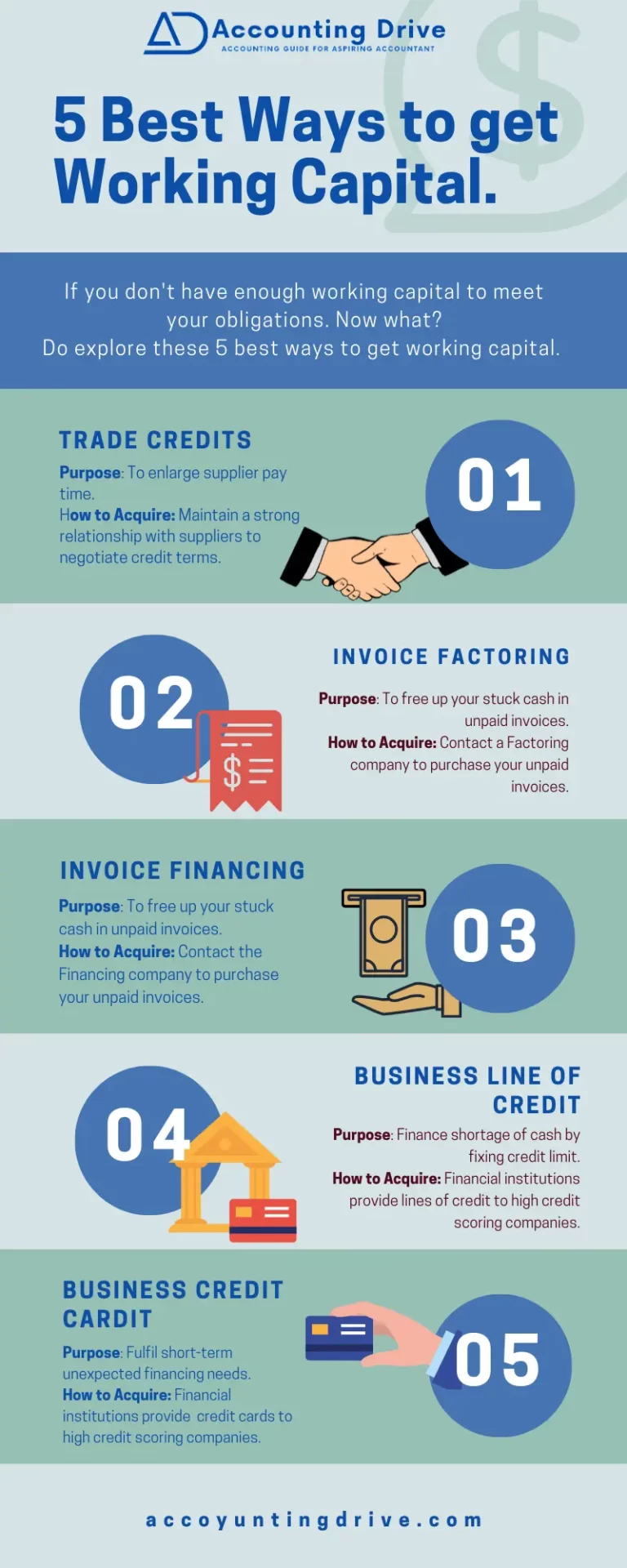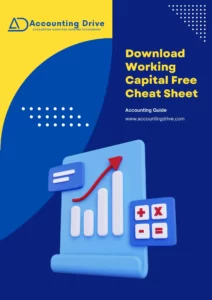Is your working capital (WC) is enough? Or do you require more WC? – How will you get the required working capital? What are the different best ways to get working capital?
Every business owner needs working capital or on-hand cash to meet day-to-day business obligations. Running a business is not a piece of cake. To remain solvent, relying on paper profit is not enough.
So, you need on-hand cash to pay your bills, rent, utility expenses, payrolls, buying inventory, marketing expenses, and other business obligations. In addition, growing companies might require to maintain high-level of WC because of the following reasons:
- Enlarge production capacity
- Explore new markets
- Make bulk purchases
- Fulfill needs during busy seasons
Therefore, the first step is to determine the working capital requirement of your business. Do you have enough WC, or do you need more? You can determine it by using the working capital ratio. Where you divide current assets with your current liabilities. It gives us a clear picture of the company’s liquidity position. If your WC ratio is 2:1, it indicates that you have enough on-hand cash to pay your current liabilities. But if it lowers down to 1:1, it imposes a threat on the company’s solvency. Hence, you must take prompt action to fulfill your WC needs by assessing different ways of increasing your working capital.
There are ample available options for businesses to get working capital. You have to decide which one is best for your organization. So. Let’s explore them with me.
Ways To Get Working Capital
In This Article
Toggle1. Trade Credits
| Purpose: To enlarge supplier pay time. |
| How to Acquire: Maintain a strong relationship with suppliers to negotiate credit terms. |
| Best Option For: Manufacturing and Retail Companies. |
Trade credit is one of the most powerful ways to increase the level of working capital which helps you to stretch your pay time. This could only be done when you build a strong long-term relationship with your vendor. Usually, credit terms lie in between 30 to 90 days of stretched pay time, where you pay to suppliers after 30 or 90 days of purchase.
Example:
Assume Feroz Textile Company receives a large order from one of its potential customers. But in order to fulfill the order requirements, a large amount of working capital is needed. Thus, a good option a company can use is to purchase material from Rohan with whom the company maintains a strong long-term relationship. Rohan offered 90 days credit term. Thus, Feroz Textile has enough time for production, selling, and collecting payments from their customers.
2. Invoice Factoring
| Purpose: To free up your stuck cash in unpaid invoices. |
| How to Acquire: Contact a Factoring company to purchase your unpaid invoices. |
| Best Option For: B2B, Manufacturing and retailing Companies. |
Another way to increase your working capital is to use the invoice factoring option. Invoice factoring frees up your cash stuck in unpaid invoices. Overdue and unpaid invoices cause a serious halt to your smooth-running cash flows. Therefore, invoice factoring allows you to sell your unpaid invoices to factoring companies who purchase usually on 70% to 80% of invoice face value.
Example:
Assume Mr. Johnson has unpaid invoices of over $40,000. Currently, he needs cash on hand to fulfill another consignment. In this scenario, the best option is invoice factoring. Mr. Johnson contacted the factoring company that purchase his unpaid invoices for $30,000- 75%. Now, the factoring company will collect all invoices on behalf of you from your customer. After collecting all payments, the company will pay the rest of the amount ($5,000) after deducting its fee ($5000).
3. Invoice Financing
| Purpose: To free up your stuck cash in unpaid invoices. |
| How to Acquire: Contact the Financing company to purchase your unpaid invoices. |
| Best Option For: B2B, Manufacturing and retailing Companies. |
Invoice financing is slightly different from invoice factoring where you have full control over your invoices. Invoice financing allows you to receive the full value of your unpaid invoices after deducting a flat fee. In addition, you will collect invoices from your customers at maturity time and your customers will never know that you are doing invoice financing. Moreover, financing companies allow over 2 months’ time duration to pay them back.
Example:
Let’s consider the above example where Mr. Johnson has $40,000 unpaid invoices. If he will go for the invoice financing option, he will receive the full payment of $35,000 after deducting the flat fee right at the time. In addition, Mr. Johnson’s customers will remain unaware of his invoice financing because Mr. Johnson will collect invoice payments from its customers. Thus, Mr. Johnson will pay the invoice amount after 12 months.
4. Business Line of Credit
| Purpose: Finance shortage of cash by fixing credit limit. |
| How to Acquire: Financial institutions provide lines of credit to high credit scoring companies. |
| Best Option For: Companies with high credit scoring. |
A business line of credit is another viable way to fulfill WC needs. A Business Line of credit is different from traditional business loans. A Business Line of credit provides you an opportunity to withdraw cash at a certain defined limit to finance your cash flow requirements. You can borrow money whenever you needed. When you borrow money, you can pay it back after one or according to the credit terms. Also, you have to pay interest on borrowed amount instead of on the full credit limit.
Example:
Assume X Company with great credit scoring gets a $10,000 line of credit from a financial institution in June. To pay its outstanding payrolls, the company withdraws $5,000 in September. According to credit terms, the company pays back with interest payments in October. Hence, the full limit restores.
5. Business Credit Cards
| Purpose: Fulfil short-term unexpected financing needs. |
| How to Acquire: Financial institutions provide credit cards to high credit scoring companies. |
| Best Option For: Companies with high credit scoring. |
In order to finance your unexpected short-term expenses, business credit cards are another viable option. Business credit cards are widely used for making payments for business purchases and for prior bookings. Interest rate and timely debt payment is crucial in business credit cards because it charges an average of 14.16% interest rate.
Example:
Assume Miss Jena holds a Business credit card. She usually uses her card for paying short-term expenses. In addition, she maintains good credit scoring by paying on time but considers it a costly option because of high-interest rates.
Which is Most Effective?
Deciding on the single best way to get working capital is difficult. You must compare each alternate option with its associated cost and terms. In addition, the decision must depend on the business’s current situation, its timeline, nature, size, and credit scoring. Moreover, you might use different ways under different business scenarios- use several ways at a time.
Key Points
- In order to fulfill short-term cash requirements, you can follow the aforementioned best ways of getting working capital.
- Under different seniors, companies use different ways to fulfill working capital requirements.
- When you need short-term financing, you might use business credit cards or a business line of credit.
- High credit scoring is essential for business credit cards or business lines of credit.
- Invoice factoring and invoice financing allow to receive early payment of unpaid invoices.
- Building strong long-term relationships with vendors and suppliers is essential for increasing trade credit terms.
Was this post helpful? Comment below. Tell me what you want to learn more about.
Recommended Articles
Get Free access to the AD's working capital cheat sheet
Grab your cheat sheet now by clicking the button !!



